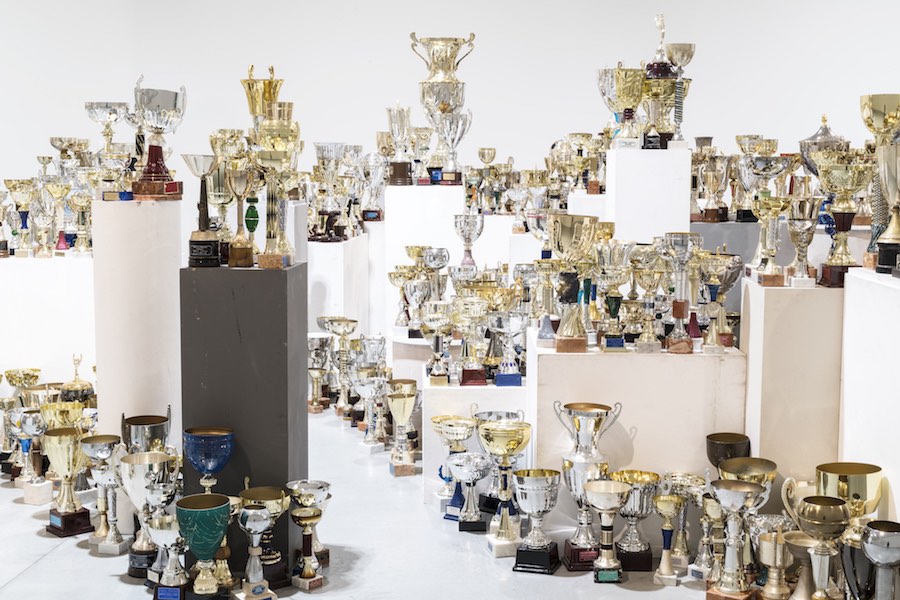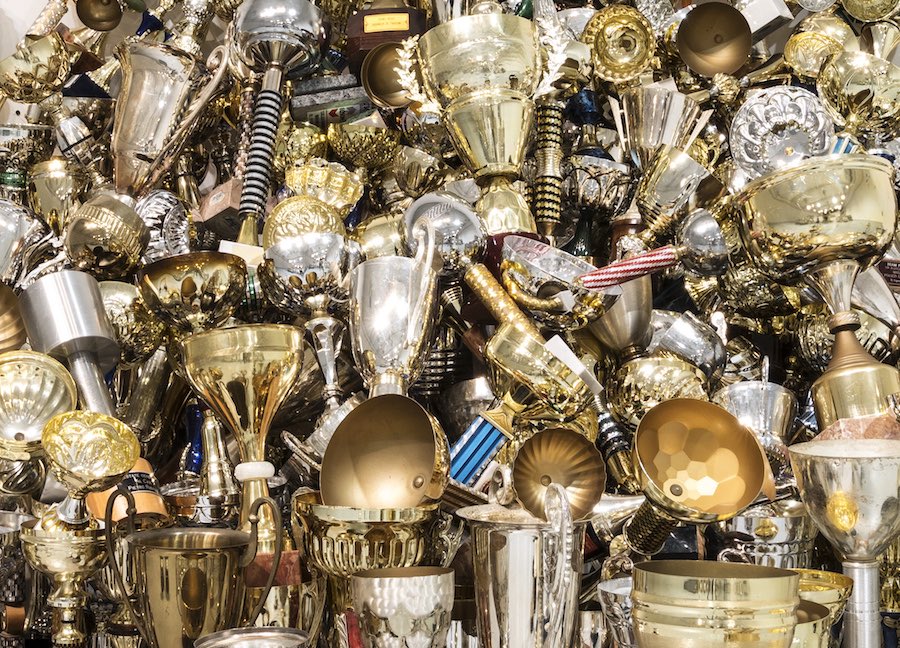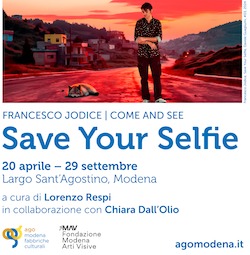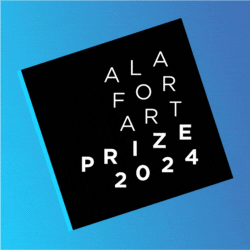
English text below
Testo e intervista di Giulia Trojano —
Entrando nello spazio dedito all’installazione di Triumph di Aleksandra Mir – fino al 7 aprile al Centro Pecci di Prato – non ci si può che meravigliare davanti alla schiera di 2529 trofei resi abbaglianti dalla forte luce solare, amplificata da un particolare tipo di illuminazione naturale filtrata da fori sul soffitto.
I trofei splendenti, reliquie di vittorie passate, sono emblematici del nostro rapporto con la gloria. La desideriamo, combattiamo per essa e alla fine, con il passare degli anni, i riconoscimenti accumulati si ingrigiscono sotto strati di polvere; chi li eredita si allontana dalle fatiche di chi li ha conquistati; diventano oggetti kitsch, magari lasciati in una scatola, dimenticati nel garage.
L’installazione è curata da Marta Papini, curatrice del Centro Pecci, alla quale ho posto alcune domande per entrare nel vivo dell’opera e apprezzarne la storia e le sfumature.
Aleksandra Mir, trasferitasi a Palermo nel 2005, ha comprato dei trofei da un antiquario siciliano per arredare casa e ben presto, coloro che visitavano il suo appartamento, iniziarono a chiederle se fossero suoi, nonostante le svariate discipline. L’artista, stimolata da ciò, ha messo un annuncio su “Il Giornale di Sicilia”, offrendo 5 euro in cambio di ogni trofeo. Nell’arco di un anno ha iniziato ad accumulare una collezione unica.

Camminando attentamente tra i vari podi, ed evitando di urtare i trofei posti per terra senza un immediato senso di logica, sembra di ritrovarsi proprio in un negozio di antiquariato, pieno di oggetti dati via per fare spazio in casa, per liberarsi di cimeli ormai senza valore. Nell’accumulo colpisce la lucentezza delle superfici, tanto da diventare dei veri e propri specchi caleidoscopici.
E’ proprio grazie alla proprieta’ caleidoscopica delle coppe che ci si immedesima nella sensazione provata dal vincitore del trofeo, come se fossimo noi, circondati melancolicamente dai nostri successi, ineluttabilmente passati. Ecco quindi che si diventa campioni di ping-pong, di freccette, classificati alla festa dei ragazzi di carnevale e vincitori del noto torneo di tennis “Ma cu m’u fici fari!!!”.
Oltre alla voglia di leggere in dettaglio la base dei trofei, si inizia ad apprezzarne la forma, i colori vivaci e i dettagli impreziositi da inserti di varia natura. Viola, velluto blu, oro – colori associati all’opulenza della chiesa cattolica e che aggiungono un ulteriore elemento venerativo, reso ancor piu’ forte dalla parete finale dell’installazione: una montagna di coppe la cui posizione triangolare ricorda visivamente un altare ecclesiastico esaltato dai giochi di luce riflessi sulla parete circostante.
La coppa, cimelio della storia del vincitore ormai dimenticato, puo’, tramite uno stimolo esterno – l’ annuncio su di un giornale di Aleksandra Mir – scaturire una reazione a catena, avvicinandoci sia al ricordo di un passato nostalgico sia alla condivisione di nuove storie, nuove interazioni.

Intervista con Marta Papini
Giulia Trojano: Perché hai scelto di portare Triumph a Prato e perche’ pensi sia un’opera attuale, da presentare proprio in questo momento?
Marta Papini: Nel 2012, quando partecipai alla prima edizione di Campo, Irene Calderoni mi suggerì di aggiungere questo lavoro di Alksandra Mir all’ipotesi di mostra di fine corso. La mostra si sarebbe intitolata In Case of Moon Disaster e si concentrava sull’opportunità di contemplare il fallimento come possibile risultato di ogni progetto che intraprendiamo. Ho amato subito Triumph. Era la sintesi perfetta di quello che cercavo di testimoniare con la mostra: un’immagine a prima vista accattivante, letteralmente luccicante e vittoriosa, ma al tempo stesso attraversata da una vena di tristezza e nostalgia.
Come i veri capolavori, non credo che perda mai di attualità: perché parla di competizione, di gloria e di orgoglio, e ci ricorda che, in quanto umani, in ogni momento possiamo smettere di vincere, che per alcuni può equivalere a fallire. È un’esperienza umana condivisa universalmente, e per questo non può che essere attuale.
GT: In quale modo il Centro Pecci è stato l’ambiente ideale per accogliere l’opera?
MP: È stata una unione di intenti: Aleksandra cercava da tempo una casa in Italia per l’opera. Lo considera un patrimonio della storia popolare italiana, e voleva che tornasse nel nostro Paese. Per questo ha deciso di donarla al Centro Pecci. Dall’altra parte, sotto la direzione di Cristiana, il museo vuole aprire i propri spazi e la propria collezione a un sempre maggior numero di artiste female-identified. Pensa solamente che non è stata fatta una mostra personale di una artista in trent’anni. È un elemento che vogliamo tenere in considerazione per aggiustare il tiro nella programmazione futura, e l’acquisizione di Triumph rientra in questo obiettivo.

GT: Nell’allestire l’opera, ci sono state istruzioni particolari? Hai anche te una coppa preferita?
MP: Avevo già lavorato con Aleksandra per The Artist is Present a Shanghai: è un’artista generosa che riconosce che le opere, una volta mostrate, non sono più sotto il suo controllo. Come curatrice ho ammirato moltissimo la scelta di abbandonare l’opera nelle mie mani: è stato un segno di stima, ma anche una grande responsabilità, come quei giochi di fiducia dove ti abbandoni nelle braccia di un altro lasciandoti cadere all’indietro. Mi interessava esaltare il sentimento di decadenza, di accumulo spasmodico e privo di scopo, invece di riordinare le coppe secondo categorie formali come era stato fatto nei precedenti allestimenti. Volevo sottolineare l’aspetto funereo dell’opera, quello che di solito caratterizza gli oggetti (apparentemente) preziosi ma caduti nell’oblio, ammassati senza un ordine e un senso. Nella mostra la dimensione del cimelio, glorificato in quanto unico, si perde completamente, a favore di un senso di oppressione quasi claustrofobico: per questo posso risponderti che ho avuto molte coppe favorite durante l’allestimento, ma credo che solo nell’insieme diano il loro meglio.
GT: Hai notato reazioni particolari dei visitatori nell’osservare l’opera?
MP: Moltissimi si offrono di portare le proprie coppe, per liberarsene così come hanno fatto quelli che all’epoca le hanno consegnate a Aleksandra. È come se il trofeo fosse la fotografia di un vecchio sportivo, ormai reso irriconoscibile dal passare degli anni, dall’inflaccidirsi dei muscoli, dall’ingrigirsi dei capelli. Pochi vorrebbero avere davanti agli occhi un ricordo del genere, meglio liberarsene con un gesto catartico. Così è nato Triumph ed è interessante che continui a stimolare lo stesso desiderio di liberazione ogni volta che viene esposto: nelle sedi precedenti (Francoforte e Londra) durante il disallestimento siano stati trovati alcuni trofei in più rispetto a quelli che erano stati installati.

Triumph: bringing a glorious past back to light. Aleksandra Mir at Centro Pecci
Interview and text by Giulia Trojano
Upon entering the space devoted to Aleksandra Mir’s Triumph, on view until 7 April at Centro Pecci in Prato, one cannot help but marvel at the 2,529 dazzling trophies, bathed in bright sunlight, amplified by a specific natural light mechanism that filters through holes dotting the ceiling.
The shining trophies, relics of past victories, are emblematic of our relationship with glory. We crave it, fight for it and ultimately, as years pass, accumulated accolades grow layers of dust; those who inherit them grow naturally detached from the sweat their owner shed; eventually they become kitsch objects – perhaps left in a box in someone’s garage.
The installation is curated by Centro Pecci’s curator, Marta Papini, to whom I asked a few questions in order to get to the heart of the work, and to appreciate its history and nuances.
Aleksandra Mir, who moved to Palermo in 2005, bought a few trophies from a Sicilian antique shop to decorate her new home and soon those who visited her apartment began asking if these were her own, despite the variety in disciplines. The artist, prompted by this, put an ad on “Il Giornale di Sicilia”, offering 5 euros in exchange for each trophy. Within a year, she began accumulating a unique collection.
Treading carefully between the podiums, trying to avoid clumsily hitting the trophies scattered on the ground with no immediate sense of logic, we seem to find ourselves in an antique shop, filled with objects that were given away to make room in a home; to get rid of now worthless relics. Most striking of all, in the midst of this mass accumulation, are the shiny surfaces, which become kaleidoscopic mirrors.
It is precisely due to the kaleidoscopic properties of the trophies that we identify with the sensation felt by their winners. It’s as if we were them, melancholically surrounded by our victories, inescapably stuck in the past. So we become champions of ping-pong and dart tournaments, proudly qualify in the youth carnival party contest and win the world-famous “Ma cu m’u fici fari!!!” tennis tournament.
Besides the desire to read in detail the plaque on the base of each trophy, we begin to appreciate their shape, their vivid colours and their embellishments, made with all kinds of materials. Violet, blue velvet, gold – colours we associate with the opulence of the Catholic church and which add an element of veneration to the work, made even stronger by the installation’s final section: a mountain of trophies whose triangular composition visually recalls an ecclesiastical altar, enhanced by reflections of light dancing on the surrounding wall.
The trophy, a relic of the forgotten victor’s history, can, through an external stimulus – the ad in a newspaper by Aleksandra Mir – trigger a chain reaction, bringing us closer to the nostalgic memory of the past, and also lead to the sharing of new stories, to new interactions.
ATP Talk – Interview with Marta Papini, curator at Centro Pecci
Giulia Trojano: Why did you choose to bring Triumph to Prato, and why do you think the work is current and should be presented now?
Marta Papini: In 2012, when I participated in the first edition of Campo, Irene Calderoni suggested that I add this work by Aleksandra Mir to my proposal for the end-of-course exhibition. The show would have been entitled In Case of Moon Disaster and focused on the chance to contemplate failure as a possible outcome of every project we undertake. I loved Triumph immediately. It was the perfect synthesis of what I was trying to document with the exhibition: an image that, on first impact, appeared captivating, literally shimmering and victorious, but one that was equally traversed by a vein of sadness and nostalgia.
Like true masterpieces, I don’t think it will ever lose its relevance: it speaks of competition, of glory and pride and it reminds us that, as humans, we can cease winning at any time, which, for some, amounts to failure. It is a universally shared human experience and for this reason, it could only ever be current.
GT: What made Centro Pecci the perfect environment to host the work?
MP: It was a combination of goals: Aleksandra, on her part, had long been looking for a home in Italy that could welcome the work. She considers it as cultural heritage of Italian popular history, and wanted it to return to our country. This is why she decided to donate it to Centro Pecci. On the other hand, under the direction of Cristiana, the museum wanted to open its spaces and its collection to an increasing number of female-identified artists. Just think about the fact that a female-identified artist hasn’t had a solo show in 30 years. It’s a factor that we want to take into account when thinking about planning future shows, and the acquisition of Triumph falls within this objective.
GT: Were you given specific instructions when installing the work? Do you also have a favourite trophy?
MP: I had already worked with Aleksandra in Shanghai for The Artist is Present: she is a generous artist who recognises that works, once shown, are no longer under her control. As a curator I very much admired her choice to leave the work in my hands: it was a sign of esteem, but also a great responsibility, like those trust games where you let yourself fall backwards into the arms of another. I was interested in exalting the feeling of decadence, of spasmodic and pointless accumulation, rather than rearranging the trophies according to formal categories as had been done in previous installations. I wanted to underline the funereal aspect of the work, the one that usually characterises (seemingly) precious objects that have fallen into oblivion, piled up without an order and logic. In the exhibition the dimension of the relic seen as glorified in its uniqueness, is completely lost, in favour of an almost claustrophobic sense of oppression: this is why I can tell you that I had many favourite trophies during the exhibition, but I believe that they give their best only as a whole.
GT: Were you able to notice any strange reactions visitors had whilst observing the work?
MP: Many offer to bring their own trophies, to get rid of them, similarly to those who gave them to Aleksandra at the time. It is as if the trophy were a photograph of an old sportsman, now unrecognisable as a result of the passing of years, the flaccid muscles, and the greying hair. Few would like to have such a memory before their eyes – better to get rid of it with a cathartic gesture. That’s how Triumph was born and it’s interesting to note that it continues to stimulate the same desire for liberation every time it’s exhibited: in previous installations (Frankfurt and London) during the dismantling stage more trophies were found than those that were installed.












